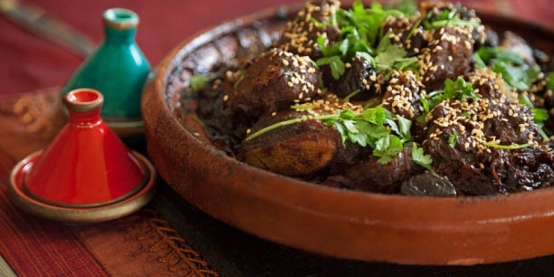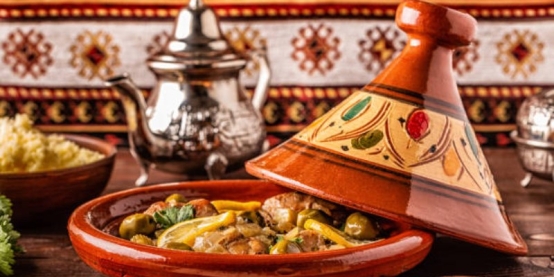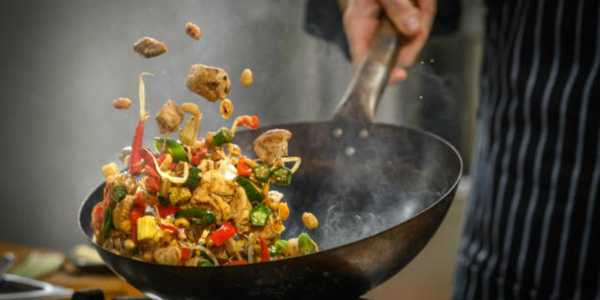Moroccan Tagine Recipes For Beginners: Easy, Authentic, And Flavorful Dishes
Few dishes capture the warmth and essence of Moroccan cooking like the tagine. For anyone curious but intimidated by Moroccan cuisine, the good news is that tagines are far friendlier to beginners than they appear.
This guide explains everything—what a tagine is, how it works, the essential ingredients, mistakes to avoid, and step-by-step beginner recipes. By the end, anyone will feel confident cooking Moroccan tagine recipes at home tonight.
Tagines stand out because they’re not just food; they’re an experience. They marry earthy spices, preserved ingredients, and slow cooking into a communal dish designed to be shared. Even for those who have never cooked Moroccan food before, starting with tagine basics is accessible, rewarding, and memorable.
What Is a Tagine?
The word "tagine" refers both to the clay pot with its distinctive cone-shaped lid and to the stew-like dish cooked inside it. The pot's design allows steam to circulate continuously, which tenderises meat, softens vegetables, and intensifies spices.

Historically, the tagine comes from Berber tradition, where nomadic communities developed this cooking method to make tougher cuts of meat flavorful and tender on open fires. Today, Morocco embraces tagine cooking as a culinary icon, with countless variations blending both sweet and savoury elements.
Cooking in a tagine is unique because it creates moisture and flavour without much water. The steam collects on the lid and drips back into the dish, transforming even simple ingredients into something aromatic and deeply layered.
Do You Need a Traditional Clay Tagine Pot?
A traditional clay tagine is the most authentic way to cook Moroccan food. However, for beginners living abroad, Dutch ovens and slow cookers are excellent alternatives.
Clay Tagine: It produces authentic flavour and texture but must be seasoned, handled gently, and used with a heat diffuser if on a stovetop.
Dutch Oven: Heavy and reliable, it retains heat beautifully and adapts well to tagine recipes.
Slow Cooker: Convenient for set-and-forget cooking, though it lacks the conical lid’s unique steam circulation.
For those without a tagine pot, using a Dutch oven with a tight lid is the easiest beginner-friendly substitute.
Essential Ingredients for Moroccan Tagines
Building authentic Moroccan tagine recipes begins with stocking a few basics:
Spices: Used in nearly every dish. Key ones include cumin, cinnamon, ginger, saffron, paprika, and ras el hanout—a blend of up to 30 spices. These give Moroccan food its fragrance and depth.
Preserved Lemons: A signature ingredient that adds tang and sharpness. If unavailable, a quick substitute is lemon slices mixed with brine or lemon zest with a squeeze of juice.
Olives & Dried Fruits: Olives provide saltiness, while apricots, dates, and prunes offer sweetness. Together, they create the sweet-and-savoury contrast Moroccan tagines are loved for.
Balancing Sweet + Savoury: A hallmark of Moroccan cuisine. Pair cinnamon-spiced prunes with lamb for rich sweetness, or preserved lemons with chicken for refreshing acidity.
Cooking Techniques Every Beginner Must Know
Mastering tagine cooking does not require advanced skills, but a few principles are crucial:
Low and Slow: Always cook tagines gently on low heat to extract deep flavours.
Toasting Spices: Briefly warm spices in oil before adding liquid. This unlocks aroma.
Flavour Layering: Start with onions, add meat or vegetables, then spices, liquid, and finally toppings.

Mistakes to Avoid: Adding too much liquid (tagines should be moist, not soupy), cooking on high heat, or rushing the process.
Patience is the hidden ingredient of Moroccan cooking—it transforms each dish into something worth savouring.
Step-by-Step Beginner-Friendly Recipes
Chicken Tagine with Preserved Lemon and Olives
Chicken pieces simmer with garlic, ginger, saffron, olives, and slices of preserved lemon.
Substitute tip: If preserved lemons are unavailable, use thin lemon slices and brine.
Result: A bright, fragrant dish ideal for first-time cooks.
Moroccan Vegetable Tagine
Vegetables like carrots, zucchini, and pumpkin are slow-cooked with cinnamon, cumin, tomatoes, and dried apricots.
Beginner note: Use large chunks of vegetables so they don’t disintegrate.
Perfect for vegetarians seeking a hearty Moroccan recipe.
Beef or Lamb Tagine with Prunes and Almonds
Slow-cooked meat paired with cinnamon-spiced prunes, toasted almonds, and saffron.
This celebratory dish demonstrates Morocco's love for balancing rich, meaty flavours with sweetness.
Quick Weeknight Tagine Hack
Use a deep skillet or Dutch oven, cover tightly with foil, and cook chicken or vegetables with Moroccan spices for 30–40 minutes.
While less traditional, it captures the essence of a tagine for busy evenings.
Serving a Tagine the Authentic Way
Traditionally, tagine is served family-style in the same dish it was cooked in, with Moroccan flatbread used to scoop up the stew. Couscous is often paired with tagines abroad, but is usually served separately in Morocco. Side suggestions include:
Moroccan carrot salad with cumin
Tomato and olive salad
Fresh herbs as garnish
The goal is communal dining, where everyone gathers around one dish.
Tips for Success & Flavour Boosting
Spice Shortcut: A teaspoon of ras el hanout instantly gives any dish a Moroccan identity, even if other spices are missing.
Add Dried Fruits and Nuts Late: To preserve texture and prevent over-softening, fold them in during the last 15 minutes.
Seasoning Adjustments: Use a balance of salt, acid (lemon), and sweetness. This maintains authenticity while allowing room for personal taste.
Beginner FAQs
Do you need special spices? Not all at once. Start with cumin, cinnamon, paprika, and ginger. Add saffron or ras el hanout later.
How to reduce sweetness? Use fewer dried fruits and increase salty ingredients like olives or preserved lemons.
Can you prep in advance? Absolutely. Marinating meat overnight with spices enhances flavour.

Are tagines better the next day? Yes. Like many stews, flavours deepen after resting overnight.
How to care for clay tagines? Cure the item before first use by soaking and oiling, then hand-wash only, avoiding harsh soaps.
Getting Started with Moroccan Tagine Recipes
Begin with simple recipes like chicken with preserved lemons or a vegetable tagine. Build confidence before moving to celebratory dishes like lamb with prunes. Experimentation is encouraged—substitute local vegetables or proteins while keeping the Moroccan essence of spice layering and sweet-meets-savoury notes.
Cooking Moroccan tagine recipes is more than preparing food—it is experiencing flavours rooted in tradition and hospitality. By starting simple and gradually layering in new techniques and spices, any beginner can enjoy authentic Moroccan dinners at home with ease.
Sources
Related Posts

The Ultimate Guide To The Ketogenic Diet For Beginners

Vegan Chocolate Avocado Mousse: Creamy Without Dairy

How To Support Thyroid Health With Nutrition

How to Make Zucchini Lasagna: A Delicious Low-Carb Alternative

Super Bowl Party Appetisers: The Ultimate Game Day Guide
